Content is from Kirkbride et al. 2006Kirkbride et al. 2006:
Kirkbride JH, Jr, Gunn CR, and Dallwitz MJ. 2006. Family guide for fruits and seeds, vers. 1.0. Accessed September 2020-January 2022. URL: https://nt.ars-grin.gov/seedsfruits/keys/frsdfam/index.cfm ., without modification.
Updates are forthcoming.
Cones: Dry, or fleshyfleshy:
texture—fairly firm and dense, juicy or at least moist, and easily cut
(Juniperus); galbulus when dry (Cupressus Spjut Fig. 9C-D, 7; 3 families: Cupressaceae (not for Juniperus), Gnetaceae, Taxodiaceae); globoseglobose:
3D shape—more or less spherical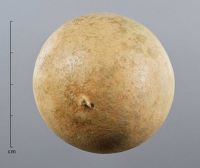 , or ovoidovoid:
, or ovoidovoid:
3D shape—ovate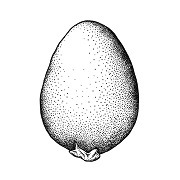 (-oblong); with scales; scales with fused subtending bracts, or scales with separate subtending bracts (rarely); arcesthida when fleshyfleshy:
(-oblong); with scales; scales with fused subtending bracts, or scales with separate subtending bracts (rarely); arcesthida when fleshyfleshy:
texture—fairly firm and dense, juicy or at least moist, and easily cut
(Juniperus). Fruiting scales present; dry (Cupressus), or fleshyfleshy:
texture—fairly firm and dense, juicy or at least moist, and easily cut
(Juniperus and drupelike); persisting (Cupressus), or disintegrating (Actinostrobus); coriaceouscoriaceous:
texture—leathery
, or woodywoody:
texture—consisting mainly of indurate lignified tissues, characteristic of or resembling wood
.
Seeds: Arilaril:
(broad sense) appendicular structure that wholly or partly envelops a seed and is produced from or a modification of the funicle, raphe, or outer integument; usually fleshy or pulpy, sometimes spongy or tufted-capillate, often brightly colored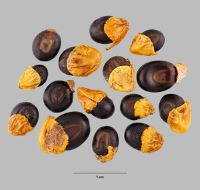 absent. Seed larger than minute; in transectiontransection:
absent. Seed larger than minute; in transectiontransection:
a cross section; representing a plane made by cutting across an organ at a right angle to its length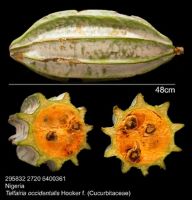 compressedcompressed:
compressedcompressed:
flattened; in grasses, used to denote compression (not necessarily flattened) either laterally or dorsiventrally
; not bowl shaped; not nutlike; without winglike beakbeak:
a usually firm, terminal appendage, sometimes tapered ; without caudatecaudate:
; without caudatecaudate:
tapering to a long, tail-like appendage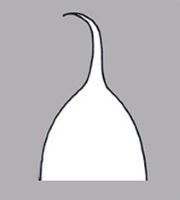 appendage(s); at maturity with food reserves; with endospermendosperm:
appendage(s); at maturity with food reserves; with endospermendosperm:
nutritive starch- and oil-containing tissue present in many seeds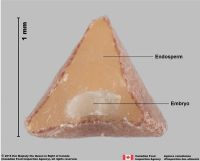 ; without canavanine. Sarcotestasarcotesta:
; without canavanine. Sarcotestasarcotesta:
pulpy or fleshy outer layer of the seed coat, simulates aril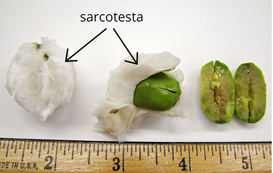 absent. Testatesta:
absent. Testatesta:
seed coat
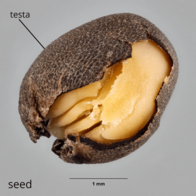 present; without fleshyfleshy:
present; without fleshyfleshy:
texture—fairly firm and dense, juicy or at least moist, and easily cut
or leatheryleathery:
texture—moderately thick, tough, and very pliable
layer over hard layer; tight; surface smooth, or unsmooth; surface with depressed features, or discreet raised features, or merged raised features; surface pittedpitted:
surface relief—surface with small depressions in which the areas between the hollows do not take on the appearance of a true reticular net ; surface granulargranular:
; surface granulargranular:
surface relief—having a grainy surface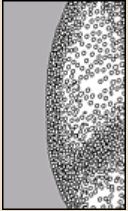 ; surface glandularglandular:
; surface glandularglandular:
surface relief—covered with small, raised secretory glands, regular or irregularly shaped, translucent or opaque, and maybe distinctly colored blisters, or rugoserugose:
blisters, or rugoserugose:
=wrinkled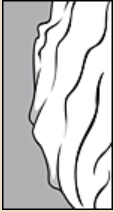 , or striatestriate:
, or striatestriate:
surface relief—having fine, parallel lines, grooves or ridges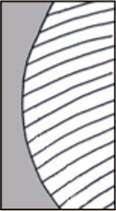 , or wrinkledwrinkled:
, or wrinkledwrinkled:
surface relief—shallow, irregular folds and furrows covering the surface; appearing overall though crumpled and then spread out ; without crease or line separating cotyledons from hypocotyl-radicle; without notch along margin where cotyledons from hypocotyl-radicle tip approach each other; without glands; without bristles; glabrousglabrous:
; without crease or line separating cotyledons from hypocotyl-radicle; without notch along margin where cotyledons from hypocotyl-radicle tip approach each other; without glands; without bristles; glabrousglabrous:
without hairs
; with wing(s), or without wings (rarely); 2-winged, or 1-winged; with wing encompassing seed, or wing on one side, or wings on both sides; with wings equally developed, or wings unequally developed; with wing(s) solid; with solid wing(s) similar to testatesta:
seed coat
 (assumed); without collar; without operculumoperculum:
(assumed); without collar; without operculumoperculum:
a dehiscent cap (or lid) of a seed or fruit that opens during germination or dehiscence
 ; colored; monochrome; brown (all shades); thinthin:
; colored; monochrome; brown (all shades); thinthin:
having or being of relatively little depth
, or membranousmembranous:
texture—extremely thin, pliable, and fairly tough
; not becoming mucilaginousmucilaginous:
resembling mucilage; moist and sticky
when wetted; surrounding food reserve. Endospermendosperm:
nutritive starch- and oil-containing tissue present in many seeds copious to scant; fleshyfleshy:
copious to scant; fleshyfleshy:
texture—fairly firm and dense, juicy or at least moist, and easily cut
; opaqueopaque:
not transmitting light
; smooth; without fatty acid containing cyclopropene; without apicalapical:
at or pertaining to the end of the seed or fruit distal from its point of attachment (i.e., base)
lobes; without chlorophyll; without isodiametric faceted surface; without odor. Embryo differentiated from food reserve; well developed; 1 per seed; partially filling testatesta:
seed coat
 (with food reserve), or nearly filling testatesta:
(with food reserve), or nearly filling testatesta:
seed coat
 (trace or scanty food reserve); at one end of seed not extending into a depression or cup; axileaxile:
(trace or scanty food reserve); at one end of seed not extending into a depression or cup; axileaxile:
on or of the axis
and centric; linearlinear:
(shape) long, narrow, and uniform in width; (of embryo) embryo is straight and much longer than wide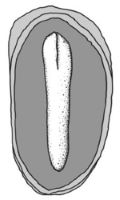 (somewhat); straight; parallel to seed length; with cotyledons gradually connected to hypocotyl-radicle; without coleorhiza; without simmondsin; without stomata; not green; with 2 or more cotyledons. Cotyledons 2, or 7 (rarely); well developed; 0.4–0.8 times length of embryo; as wide as hypocotyl-radicle, or somewhat to significantly wider than hypocotyl-radicle; 1–1.5 times wider than hypocotyl-radicle; not concealing hypocotyl-radicle; not foliaceous; moderately thickthick:
(somewhat); straight; parallel to seed length; with cotyledons gradually connected to hypocotyl-radicle; without coleorhiza; without simmondsin; without stomata; not green; with 2 or more cotyledons. Cotyledons 2, or 7 (rarely); well developed; 0.4–0.8 times length of embryo; as wide as hypocotyl-radicle, or somewhat to significantly wider than hypocotyl-radicle; 1–1.5 times wider than hypocotyl-radicle; not concealing hypocotyl-radicle; not foliaceous; moderately thickthick:
having or being of relatively great depth
; flat; smooth; with apicesapex:
the point farthest from the point of attachment, or the "tip" of an organ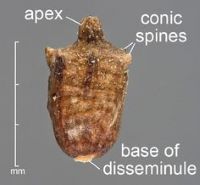 entire; with margins separate; basally entire; equal in size; not punctatepunctate:
entire; with margins separate; basally entire; equal in size; not punctatepunctate:
surface relief—dotted with pits or with translucent, sunken glands or with colored dots, similar to pitted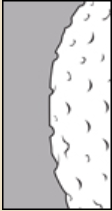 dotted. Hypocotyl-radicle well developed; straight; not thickened.
dotted. Hypocotyl-radicle well developed; straight; not thickened.
General references: Engler, A. & K. Prantl. 1924 and onward. Die Natürlichen Pflanzenfamilimien. W. Engelman, Leipzig, Gunn, C.R., J.H. Wiersema, C.A. Ritchie, & J.H. Kirkbride, Jr. 1992 & amendments. Families and genera of Spermatophytes recognized by the Agricultural Research Service. Techn. Bull. U.S.D.A. 1796:1–500, Page, C.N. 1990. Coniferophytina (Conifers and Ginkgoids). In: Kubitzki, K., ed., The families and genera of vascular plants, pp. 282–361. Springer-Verlag, Berlin, LeMaout, E. & J. Decaisne. 1876. A general system of botany, 1,065 p. Longmans, Green, & Co., London, Mabberley, D.J. 1987. The plant-book, 706 p. Cambridge University Press, Cambridge, Schopmeyer, C.S. 1974. Seeds of Woodywoody:
texture—consisting mainly of indurate lignified tissues, characteristic of or resembling wood
plants in the United States. Agric. Handb. 450:1–883, and Spjut, R.W. 1994. A systematic treatment of fruit types. Mem. New York Bot. Gard. 70:1–182.